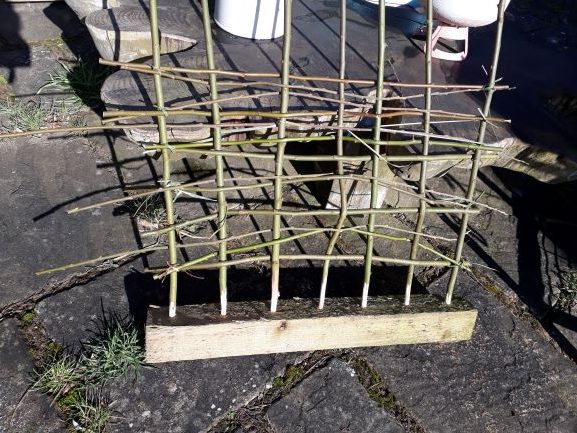We have a willow tree which suggests we should be making weaving projects. A few previous attempts proved this is not an easy task. You need to start simple. Trellis is about as simple as you can get.

Years ago the willow tree fell down. We cut it off near the base, thinking we could use the stump for something. But these trees know how to grow. You can plant a twig and it will grow. Soaking them last year trying to soften them, they started growing roots in the bath we made for them.
So this trellis cannot be planted direct in the ground. We took a scrap plank and drilled some big holes evenly spaced. This also helped to hold the uprights still while weaving – essential otherwise you cannot get a shape.

We have a plant in the garden called New Zealand Flax. If you are from New Zealand, I believe the local name is harakeke. I’ve been told by people who live there to be careful to wash your hands after handling, otherwise it could give you the runs. However my foraging book says it is edible. Hmm I will err on the side of caution I think.
Harakeke is lovely to work with. You cut off a leaf at the base – the instructions say take from the outside to avoid damaging the plant. A mature plant has hundreds of leaves, so you’re spoilt for choice. Then just split the leaf near the edge and tear. You can tear narrow or broad as you require. And use it as string. It is supple. After cutting a leaf it is still good to use for a week or more. And so strong, you really can tie things tight with no processing to make it a string.
All knots in making this trellis are done with harakeke.

There are two trellises. The second one, on the right in the picture, is much better than the first. But that’s the whole point. Learning to work with willow. And it did not want to be too pretty. It is supposed to support the flowers, not upstage them.
I’m very happy that the entire structure is natural, and most of it is from the garden. The idea is to be self-supporting, and to reduce our carbon footprint by using resources found as close to home as possible.
